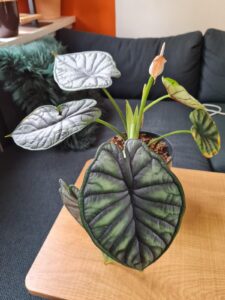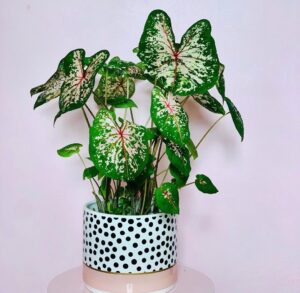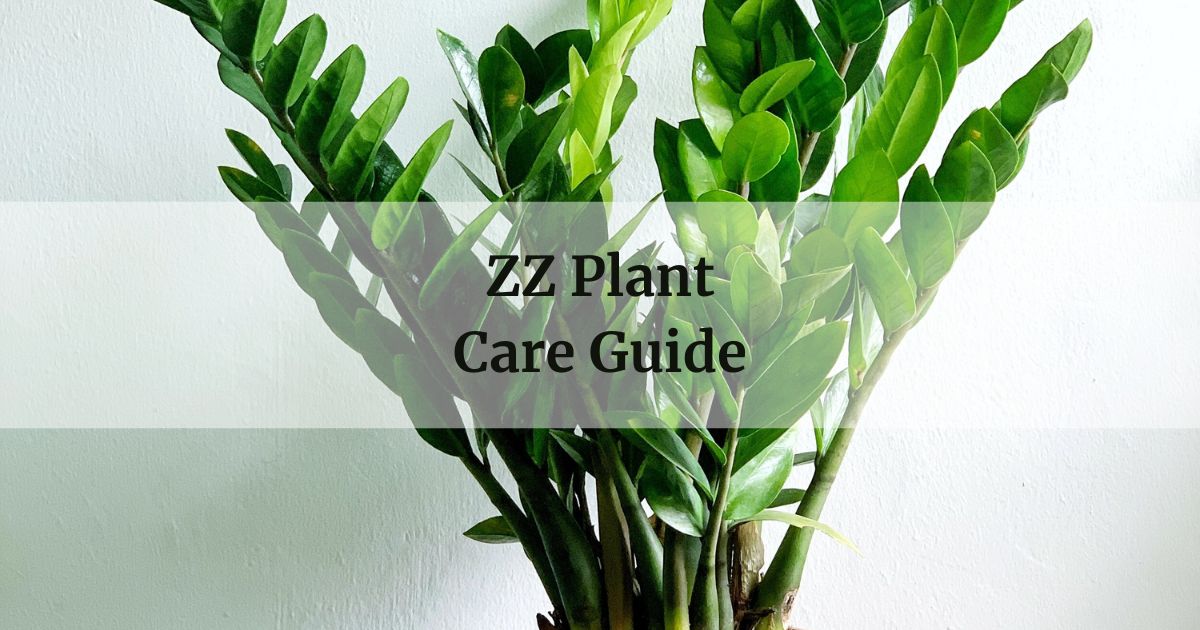
I’m a busy mom, so I always choose plants that not only bring greenery into my space but also grow with minimal effort. The ZZ Plant (Zamioculcas zamiifolia) fits perfectly into this category. Its resilient nature and striking appearance make it a staple in any indoor garden. It has beautiful glossy, deep green leaves and an ability to withstand neglect. Perfect for a busy household!
- Pros:
- Requires minimal watering
- Thrives in low light conditions
- Air-purifying properties
- Cons:
- Toxic to pets if ingested
In this article
- 1 Appearance of the ZZ Plant
- 2 Caring for ZZ Plant
- 3 Toxicity Level of ZZ Plant
- 4 Light Requirements for the ZZ Plant
- 5 Watering the ZZ Plant
- 6 Fertilizing the ZZ Plant
- 7 Potting the ZZ Plant
- 8 Propagation of ZZ Plant
- 9 Growth and Development of the ZZ Plant
- 10 Managing Pests and Diseases for the ZZ Plant
- 11 Complimentary Plants with your ZZ Plant
Appearance of the ZZ Plant
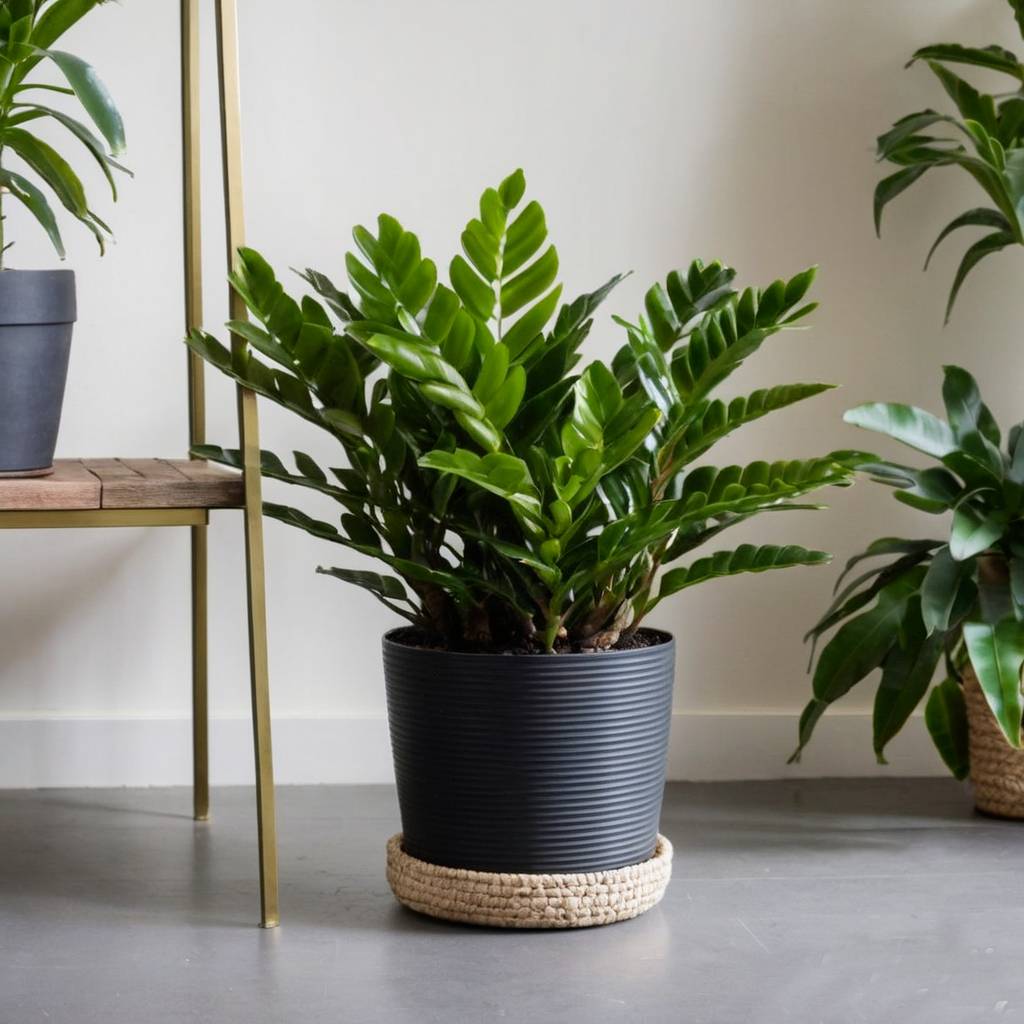
The ZZ Plant boasts sturdy, upright stems with glossy, dark green leaves that have a waxy texture. Its compact growth habit makes it ideal for small spaces.
Here’s a quick rundown of its key features:
- Leaf shape: Oval-shaped leaflets attached to thick stems
- Size: Can grow up to 2-3 feet tall
- Beginner-friendly: Perfect for those new to plant care
- Water requirements: Drought tolerant, requires minimal watering
- Sunlight requirements: Thrives in low to moderate indirect light
- Pot size required: Prefers a snug pot, doesn’t need frequent repotting
Great for People who:
If you want add a touch of tropical elegance to your home without the hassle of constant upkeep, the ZZ Plant is your go-to choice.
Great for these Spaces:
A room with higher ceilings provides the ideal environment for the ZZ Plant to flourish. Its vertical growth adds a touch of sophistication to any space.
Caring for ZZ Plant
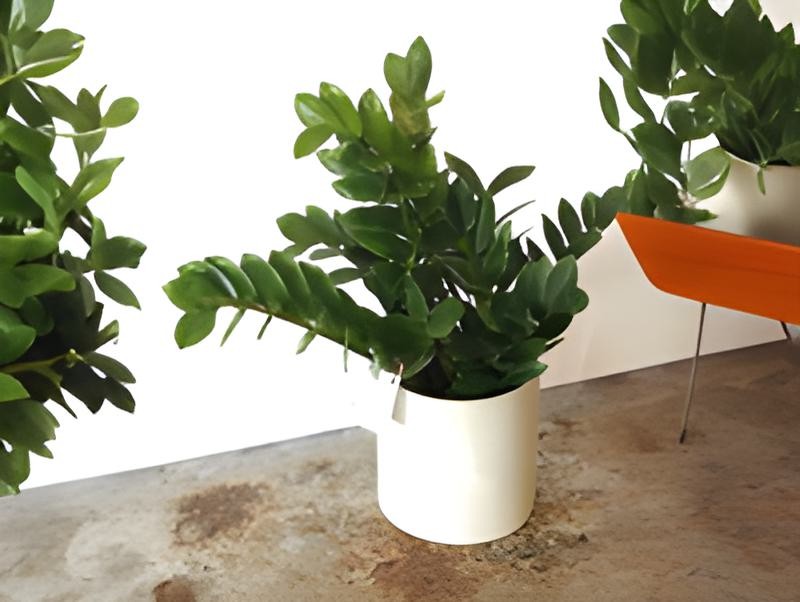
Unlike some finicky houseplants that require constant attention, the ZZ Plant thrives on neglect. I quickly learned that it prefers to be left alone rather than fussed over.
When it comes to watering, I made a point to err on the side of underwatering rather than overwatering. I found that the ZZ Plant is quite sensitive to excessive moisture, which can lead to root rot. By allowing the soil to dry out completely between waterings, I was able to maintain the perfect balance of moisture for optimal growth.
Toxicity Level of ZZ Plant
Please note the toxic compounds found in the ZZ Plant, including calcium oxalate crystals, can cause irritation and discomfort if ingested. As a responsible pet owner, it’s essential to keep this plant out of reach or opt for pet-safe alternatives. I made sure to keep the ZZ Plant out of reach of pets and placed it in areas where children couldn’t access it easily.
Despite its toxicity, I didn’t let fear overshadow my appreciation for the ZZ Plant’s beauty and resilience. By implementing simple precautions and remaining vigilant, I was able to enjoy the presence of the ZZ Plant without compromising the safety of my loved ones.
Light Requirements for the ZZ Plant
In terms of light requirements, I discovered that the ZZ Plant is incredibly versatile. While it prefers bright indirect light, it can also tolerate lower light conditions with ease. This flexibility makes it a perfect choice for rooms with limited natural light. It can tolerate a wide range of light conditions, from bright indirect light to low light.
Here’s a breakdown:
| Light Conditions | Effect on ZZ Plant |
|---|---|
| Bright Indirect Light | Promotes growth |
| Low Light | Thrives |
| Direct Sunlight | Can cause leaf burn |
Watering the ZZ Plant
Watering the ZZ Plant is where I initially struggled. At first, I tended to overwater, thinking it needed more hydration. However, I soon discovered that less is more when it comes to this plant. Here are some watering guidelines to follow:
- Allow the soil to dry out completely between waterings.
- Water sparingly, especially during the winter months.
- Avoid leaving the plant sitting in water, as it can lead to root rot.
Fertilizing the ZZ Plant

Indoor Plant Fertilizer Pellets- Suitable for just about any kind of indoor plants. It’s great for seedlings and mature plants alike.
Fertilizing the ZZ Plant is straightforward and doesn’t require frequent feeding. Here’s what I’ve learned:
- Fertilize during the growing season (spring and summer) with a balanced liquid fertilizer.
- Dilute the fertilizer to half strength to prevent overfeeding.
- Apply fertilizer once a month, following the instructions on the label.
| Month | Recommended Dosage |
|---|---|
| Spring | 1/2 strength |
| Summer | 1/2 strength |
| Fall | Skip |
| Winter | Skip |
Potting the ZZ Plant

Potting the ZZ Plant is a task I’ve tackled with ease. Its slow growth rate means it doesn’t require frequent repotting. Here’s what I’ve learned:
- Choose a well-draining potting mix to prevent waterlogging.
- Repot every 2-3 years or when the plant outgrows its current container.
- Select a pot that’s slightly larger than the current one to allow room for growth.
Propagation of ZZ Plant
Propagation of the ZZ Plant is a rewarding experience and easy to do. Here’s a step-by-step guide based on my personal experience:
- Take stem cuttings from a healthy ZZ Plant.
- Allow the cuttings to dry for a few days to callus over.
- Plant the cuttings in a well-draining potting mix.
- Keep the soil consistently moist until roots develop.
- Once roots have formed, treat the new plant like a mature ZZ Plant.
Growth and Development of the ZZ Plant
The ZZ Plant’s ability to thrive despite occasional neglect serves as a testament to its adaptability and tenacity. Furthermore, I’ve noticed that providing regular care and attention, such as occasional pruning and dusting of leaves, can significantly enhance its overall appearance and health.
Optimal conditions for growth:
- Light: Bright indirect light is best, but it can tolerate low light conditions.
- Humidity: Moderate humidity levels are sufficient.
- Temperature: Keep the plant in temperatures between 65-75°F.
- Best time to grow in the United States: Spring and summer are ideal for growth.
As for cleaning, I’ve found that gently wiping the leaves with a damp cloth removes dust and keeps the plant looking fresh.
RELATED: Worst for Beginners: 7 Houseplants to AVOID as a New Gardener
Managing Pests and Diseases for the ZZ Plant
While the ZZ Plant is relatively pest and disease-resistant, it’s not entirely immune. Keep an eye out for common pests like mealybugs and spider mites. If infestation occurs, treat with insecticidal soap or neem oil.
Complimentary Plants with your ZZ Plant
Pairing the ZZ Plant with other low-maintenance houseplants can create a stunning indoor oasis.
In conclusion, the ZZ Plant is a true gem in the world of indoor gardening. Its resilience, striking appearance, and low maintenance nature make it a must-have for any plant enthusiast. With proper care and attention, you can enjoy the beauty of the ZZ Plant for years to come.
Remember, gardening is a journey of discovery. By taking a page out of my playbook, you can cultivate a thriving indoor garden filled with lush greenery and vibrant life.


